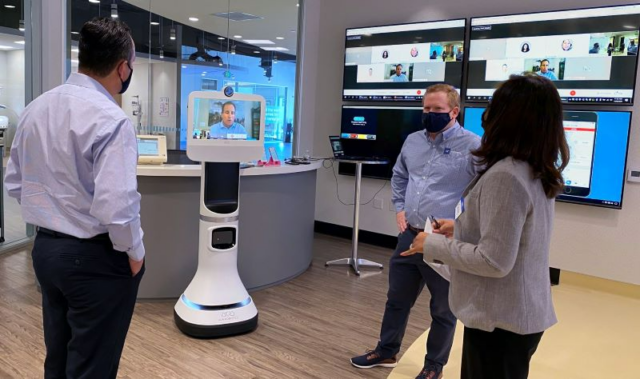The world of work radically changed over the last year and a half. It’s anyone’s guess what it will look like in the next few months, let alone the next couple of years. But that’s not stopping the “techpreneurs” behind these five technologies for the new era of work who are betting millions that their ideas will take off—literally, in some cases.
1. Software robots
Automation has transformed manufacturing, and now robots are ready to take the load off office work, too. If executives at companies such as UiPath have anything to say about it, soon software that points, clicks and sends emails for us will be as ubiquitous as the spreadsheet is today.
“Everyone has on his or her or plate today 10, 20 different activities,” UiPath CEO Daniel Dines said in a recent interview. “Some of them can be completely delegated to robots. They are the low-value type of activities.”
Dines doesn’t want to replace humans. Instead, he wants to free the humans to do higher-value, more interesting activities such as “interaction with people, creativity and decision-making” by taking over their boring office tasks.

UiPath aims to build a future where every office worker has access to easily programable software robots that do such tasks as gathering information from documents and websites, scheduling meetings, filling out forms and more. It’s part of the robotic process automation software market that Gartner predicts will hit $2 billion in revenue in 2021.
2. Internet everywhere
Forty percent of the world’s population still lacks access to the internet. A new breed of space-based internet providers, driven by the falling coast of rocket launches, aims to change that with constellations of low-flying satellites that promise to bring fast, low-latency internet services to every corner of the globe.
SpaceX’s Starlink has 1,800 satellites in orbit and counting, and beta testing is underway with more than 69,000 users. The company is set to blanket the globe with connectivity by the end of 2021. Already, people in remote areas are getting online where they couldn’t before, opening up new possibilities for work, education and play.
Next, SpaceX plans to offer stable, high-speed connections on moving vehicles, including airplanes, ships, trucks and even RVs, letting people reliably connect anywhere on the go. As SpaceX recently stated in a filing with the U.S. Federal Communications Commission regarding its planned new mobile service, “No longer are users willing to forego connectivity while on the move, whether driving [a] truck across the country, moving a freighter from Europe to a U.S. port or while on a domestic or international flight.” Now you’ll have no excuse for not logging into that meeting.
3. Passenger drones
The dream of the flying car enabling short hops within urban centers away from the snarl of ground traffic is finally nearing reality, thanks to millions of dollars of investment in automated passenger drones from the likes of Boeing, Daimler, GM and other major transportation companies.

Bloomberg New Energy Finance analyst Alejandro Zamorano-Cadavid sees air mobility as the next logical step in the evolution of urban transport. “Cities are getting more congested, and urban dwellers don’t want to own cars,” he said in a recent video report. “So anything that can move an urban dweller from A to B is interesting to investors. We saw it with micro-mobility solutions. We saw it with shared mobility solutions. The next natural step is shared aviation solutions.”
California-based passenger drone company Joby went public on the New York Stock exchange in August 2021. The move brought the company’s total valuation to $4.5 billion. The company aims to put its five-seat electric vertical-takeoff and landing air taxi into service in 2024. Could traffic jams go the way of horses and buggies?
4. Smart workspaces

The office of 2022 could look very different from the office of 2019. With more people working at home as well as in traditional office and meeting spaces, technology for keeping everyone productive and in sync is getting a boost from artificial intelligence (AI).
AI powers autonomous disinfecting robots from Ava Robotics, meeting kits from Google that bring clarity to presenters even in big, echoing conference rooms, and even a chatbot from Wysa that detects signs of employee burnout. An employer-provided app that listens to all your troubles and tries to talk you through them before you do something rash like quit might sound creepy. But Wysa insists that everything you tell it stays anonymous, and it will only refer you to employer-provided health services if you need it. Instead of personally identifiable information, employers receive aggregate data telling them how their workforce is doing overall.
“People ask us whether we’re trying to replace therapists,” Wysa co-founder Jo Aggarwal said in a recent video interview. “I often ask them back, ‘What business do therapists have being that person that we talk to at 4 a.m.?'”
5. Telepresence
When conventional teleconferencing simply won’t cut it, telepresence robots give remote workers a physical presence anywhere there’s an internet connection. Ava Robotics is one of the robot makers getting a boost in the new era of work.
Users of the company’s robots log into a virtual meeting on a browser just as with any other teleconferencing system. The difference here is that the remote meeting participant is also presented with a set of navigation controls. The user can click or tap waypoints to have the robot navigate autonomously or drive manually with arrow controls. All the while, the robot—which looks like a podium with a screen—lets people interact at eye level.
Ava Robotics Director of Marketing Molly Gardner says that, in addition to remote workers, Ava users include real estate buyers on property tours and hospital equipment purchasers meeting with sales reps. Near-future users could include retail locations with in-person customers interacting with remote support staff who have specialized knowledge of given products.

“Robots are going to be ubiquitous in the workplace eventually,” Gardner says. “Workplace robots are going to go way beyond telepresence as well.” Robots cleaning, inspecting and managing businesses and industrial sites are just some of the other possibilities for the future of work.
Lead photo courtesy of Joby